Investigation of the Impact of Geotextile Incorporation on the Mechanical Properties of Geopolymer
Abstract
:1. Introduction
2. Materials and Methods
2.1. Materials
2.1.1. Granite Residual Soil
2.1.2. Geotextiles
2.1.3. Alkaline Solution
2.2. Test Scheme
2.3. Methods
2.3.1. Compressive Strength Test
2.3.2. XRD Spectrum
2.3.3. Thermogravimetric Analysis
2.3.4. Scanning Electron Microscope
2.3.5. Mass Loss
2.4. Experimental Scheme
3. Results and Discussion
3.1. Compressive Strength
3.1.1. Influence of Geotextile Layers on Compressive Strength
3.1.2. Effect of Curing Conditions on Compressive Strength
3.2. Hydration Mechanism of Geotextile-Enhanced Geopolymer
3.2.1. XRD Analysis
3.2.2. TG-DTA
3.2.3. SEM Analysis
3.2.4. EDS Analysis of Geotextile Geopolymer
3.3. Mass Loss Research
4. Conclusions
- The geotextile has a strengthening effect on the geopolymer. Under the same curing time and conditions, the unconfined compressive strength of the samples with the geotextile was higher than that without the geotextile, and the compressive strength of the sample under 14-day natural curing increased from 2.57 Mpa to 3.26 Mpa, an increase of 27%.
- The compressive strength of the geopolymer did not increase directly with the increase in the number of geotextile layers. With consistent curing time and conditions, the compressive strength of the geopolymer sample with a layer of geotextile cured for 14 days increased by 23% on average compared with the sample without geotextiles, while the subsequent increase in the number of geotextile layers resulted in a small increase in compressive strength, and the optimal average value only increased by 9%. Once the number of geotextile layers in the sample reached two or more layers, the impact on the geopolymer strength became negligible and gradually decreased.
- The longer the curing time, the higher the polymer strength. But increasing the number of D-W cycle exacerbated the destruction of geopolymers. On the 14th day, the average strength of the D-W cyclic sample (1.935 Mpa) was 1.305 Mpa smaller than that of the naturally cured sample (3.24 Mpa), and the strength decreased by 40%. Under the condition of natural curing and soaking curing, the compressive strength of the geopolymer increased with the increase in time within 14 days. However, the compressive strength of the geopolymer decreased slightly under the D-W cycle condition.
- D-W cycles are unfavorable to geopolymers with geotextiles. With equal geotextile layer counts, distribution patterns, and curing times, the compressive strength of geopolymers cured naturally was markedly higher than those cured under D-W cycle conditions, which in turn were lower than those of geopolymers cured under the first two curing scenarios. But the strength of the geopolymer without geotextiles increased from day 7 to day 14. This was attributed to the effect of the geotextile on the concentration of alkali solution due to the enhanced penetration strength of the sample. This could be attributed to the wet–dry cycle which intensified the shedding of geopolymers.
- Obviously, the layering of a whole geotextile added fine fibers to the sample to improve the compressive properties of the sample, which could effectively inhibit the development of cracks in the material. Geopolymers and geotextiles can strengthen a foundation together, which is of great significance for developing common technology involving geopolymer reinforcement and geotextile layering in foundation reinforcement. Both are environmentally friendly materials, which can reduce environmental pollution. Although the results show positive results regarding the geopolymerization and strength enhancement of residual soil reinforced by geotextiles, the results may be limited by the size of the laboratory, and it is suggested that to address the latter, we could appropriately increase the sample size to better simulate the field situation.
Author Contributions
Funding
Data Availability Statement
Acknowledgments
Conflicts of Interest
References
- Cui, C.; Liang, Z.; Xu, C.; Xin, Y.; Wang, B. Analytical Solution for Horizontal Vibration of End-Bearing Single Pile in Radially Heterogeneous Saturated Soil. Appl. Math. Model. 2023, 116, 65–83. [Google Scholar] [CrossRef]
- Yuan, B.; Liang, J.; Lin, H.; Wang, W.; Xiao, Y. Experimental Study on Influencing Factors Associated with a New Tunnel Waterproofing for Improved Impermeability. J. Test. Eval. 2024, 52, 20230417. [Google Scholar] [CrossRef]
- Meng, K.; Cui, C.; Liang, Z.; Li, H.; Pei, H. A New Approach for Longitudinal Vibration of a Large-Diameter Floating Pipe Pile in Visco-Elastic Soil Considering the Three-Dimensional Wave Effects. Comput. Geotech. 2020, 128, 103840. [Google Scholar] [CrossRef]
- Yuan, B.; Sun, M.; Xiong, L.; Luo, Q.; Pradhan, S.P.; Li, H. Investigation of 3D Deformation of Transparent Soil around a Laterally Loaded Pile Based on a Hydraulic Gradient Model Test. J. Build. Eng. 2020, 28, 101024. [Google Scholar] [CrossRef]
- Dou, H.; Wang, R.; Wang, H.; Jian, W. Rainfall Early Warning Threshold and Its Spatial Distribution of Rainfall-Induced Landslides in China. Rock. Mech. Bull. 2023, 2, 100056. [Google Scholar] [CrossRef]
- Liew, Y.-M.; Heah, C.-Y.; Mohd Mustafa, A.B.; Kamarudin, H. Structure and properties of clay-based geopolymer cements: A review. Prog. Mater. Sci. 2016, 83, 595–629. [Google Scholar] [CrossRef]
- Perumal, P.; Piekkari, K.; Sreenivasan, H.; Kinnunen, P.; Illikainen, M. One-Part Geopolymers from Mining Residues—Effect of Thermal Treatment on Three Different Tailings. Miner. Eng. 2019, 144, 106026. [Google Scholar] [CrossRef]
- Temuujin, J.; van Riessen, A. Effect of Fly Ash Preliminary Calcination on the Properties of Geopolymer. J. Hazard. Mater. 2009, 164, 634–639. [Google Scholar] [CrossRef]
- Cong, P.; Cheng, Y. Advances in Geopolymer Materials: A Comprehensive Review. J. Traffic Transp. Eng. 2021, 8, 283–314. [Google Scholar] [CrossRef]
- Yuan, B.; Liang, J.; Li, X.; Zhang, B.; Luo, Q.; Sabri, S.M.M.; Muhammad, F.; Azzam, W.R.; Rao, F.; Yuan, P. Sustainable Utilization of Clay Minerals-Rich Engineering Muck via Alkali Activation: Optimization of Pore Structure by Thermal Treatment. Appl. Clay Sci. 2024, 258, 107491. [Google Scholar] [CrossRef]
- Abdullah, H.H.; Shahin, M.A.; Sarker, P. Use of Fly-Ash Geopolymer Incorporating Ground Granulated Slag for Stabilisation of Kaolin Clay Cured at Ambient Temperature. Geotech. Geol. Eng. 2019, 37, 721–740. [Google Scholar] [CrossRef]
- Hou, Z.; Liu, Y.; Han, Z.; Tang, M.; Gong, X.; Su, D.; Wang, L. Experimental Study of the Bearing Characteristics of a Novel Energy-Saving and Environmentally Friendly Pile: Drilling with Prestressed Concrete Pipe Cased Piles. Int. J. Geomech. 2024, 24, 04024035. [Google Scholar] [CrossRef]
- Zhang, X.; Zhang, X.; Li, J.; Su, L.; Liu, J. Study of the Damage Mechanism on Mechanical Properties of Super Absorbent Polymer-Improved Geopolymers under Dry-Wet Cycling. J. Mater. Sci. 2024, 59, 4662–4679. [Google Scholar] [CrossRef]
- Zhang, Z.H.; Zhu, H.J.; Zhou, C.H.; Wang, H. Geopolymer from kaolin in China: An overview. Appl. Clay Sci. 2016, 119, 31–41. [Google Scholar] [CrossRef]
- Wang, H.; Li, H.; Wang, Y.; Yan, F. Preparation of Macroporous Ceramic from Metakaolinite-Based Geopolymer by Calcination. Ceram. Int. 2015, 41, 11177–11183. [Google Scholar] [CrossRef]
- Yuan, B.; Liang, J.; Zhang, B.; Chen, W.; Huang, X.; Huang, Q.; Li, Y.; Yuan, P. Optimized reinforcement of granite residual soil using a cement and alkaline solution: A coupling effect. J. Rock. Mech. Geotech. Eng. 2024. [Google Scholar] [CrossRef]
- Yuan, B.; Chen, W.; Li, Z.; Zhao, J.; Luo, Q.; Chen, W.; Chen, T. Sustainability of the polymer SH reinforced recycled granite residual soil: Properties, physicochemical mechanism, and applications. J. Soils Sediments 2023, 23, 246–262. [Google Scholar] [CrossRef]
- Yuan, B.; Li, Z.; Zhao, Z.; Ni, H.; Su, Z.; Li, Z. Experimental study of displacement field of layered soils surrounding laterally loaded pile based on transparent soil. J. Soils Sediments 2021, 21, 3072–3083. [Google Scholar] [CrossRef]
- Yuan, B.; Chen, W.; Zhao, J.; Li, L.; Liu, F.; Guo, Y.; Zhang, B. Addition of alkaline solutions and fibers for the reinforcement of kaolinite-containing granite residual soil. Appl. Clay Sci. 2022, 228, 106644. [Google Scholar] [CrossRef]
- Nassar, R.-U.-D.; Soroushian, P.; Balachandra, A.; Nassar, S.; Weerasiri, R.; Darsanasiri, N.; Abdol, N. Effect of Fiber Type and Content on the Performance of Extruded Wood Fiber Cement Products. Case Stud. Constr. Mater. 2022, 16, e00968. [Google Scholar] [CrossRef]
- Farhan, N.A.; Sheikh, M.N.; Hadi, M.N.S. Behaviour of Ambient Cured Steel Fibre Reinforced Geopolymer Concrete Columns Under Axial and Flexural Loads. Structures 2018, 15, 184–195. [Google Scholar] [CrossRef]
- Farhan, N.A.; Sheikh, M.N.; Hadi, M.N.S. Experimental Investigation on the Effect of Corrosion on the Bond Between Reinforcing Steel Bars and Fibre Reinforced Geopolymer Concrete. Structures 2018, 14, 251–261. [Google Scholar] [CrossRef]
- Shaikh, F.U.A.; Fairchild, A.; Zammar, R. Comparative Strain and Deflection Hardening Behaviour of Polyethylene Fibre Reinforced Ambient Air and Heat Cured Geopolymer Composites. Constr. Build. Mater. 2018, 163, 890–900. [Google Scholar] [CrossRef]
- Noushini, A.; Hastings, M.; Castel, A.; Aslani, F. Mechanical and Flexural Performance of Synthetic Fibre Reinforced Geopolymer Concrete. Constr. Build. Mater. 2018, 186, 454–475. [Google Scholar] [CrossRef]
- Korniejenko, K.; Lin, W.-T.; Simonova, H. Mechanical Properties of Short Polymer Fiber-Reinforced Geopolymer Composites. J. Compos. Sci. 2020, 4, 128. [Google Scholar] [CrossRef]
- Nematollahi, B.; Qiu, J.; Yang, E.-H.; Sanjayan, J. Micromechanics Constitutive Modelling and Optimization of Strain Hardening Geopolymer Composite. Ceram. Int. 2017, 43, 5999–6007. [Google Scholar] [CrossRef]
- Zhang, H.; Bian, H.; Qi, S.; Wang, J. A Comprehensive Analysis of Formation Conditions, Intrinsic Properties, and Mechanical Responses of Gas Hydrate-Bearing Sediments. Rock. Mech. Bull. 2024, 3, 100114. [Google Scholar] [CrossRef]
- Jayawardane, V.S.; Anggraini, V.; Li-Shen, A.T.; Paul, S.C.; Nimbalkar, S. Strength Enhancement of Geotextile-Reinforced Fly-Ash-Based Geopolymer Stabilized Residual Soil. Int. J. Geosynth. Ground Eng. 2020, 6, 50. [Google Scholar] [CrossRef]
- ISO 679:2009; Cement—Test Methods—Determination of Strength. ISO: Geneva, Switzerland, 2009.
- ISO 10319:2015; Geosynthetics—Wide-Width Tensile Test. ISO: Geneva, Switzerland, 2015.
- ISO 9864:2005; Geosynthetics—Test Method for the Determination of Mass per Unit Area of Geotextiles and Geotextile-Related Products. ISO: Geneva, Switzerland, 2005.
- ASTM D2166-00; Standard Test Method for Unconfined Compressive Strength of Cohesive Soil. ASTM International: West Conshohocken, PA, USA, 2000.
- Huang, H.; Yuan, Y.; Zhang, W.; Zhu, L. Property Assessment of High-Performance Concrete Containing Three Types of Fibers. Int. J. Concr. Struct. Mater. 2021, 15, 39. [Google Scholar] [CrossRef]
- Pradhan, S.K.; Pothal, G.K. Shear Strength Characteristics of Pond Ash Reinforced with Polymeric and Natural Fiber Geosynthetic. Geotech. Geol. Eng. 2024, 42, 3897–3918. [Google Scholar] [CrossRef]
- Wu, Y.; Yamamoto, H.; Cui, J.; Cheng, H. Influence of Load Mode on Particle Crushing Characteristics of Silica Sand at High Stresses. Int. J. Geomech. 2020, 20, 04019194. [Google Scholar] [CrossRef]
- Fakhrabadi, A.; Ghadakpour, M.; Choobbasti, A.J.; Kutanaei, S.S. Influence of the Non-Woven Geotextile (NWG) on the Engineering Properties of Clayey-Sand Treated with Copper Slag-Based Geopolymer. Constr. Build. Mater. 2021, 306, 124830. [Google Scholar] [CrossRef]
- Que, X.; Zhu, Z.; Zhou, L.; Niu, Z.; Huang, H. Strength and Failure Characteristics of an Irregular Columnar Jointed Rock Mass Under Polyaxial Stress Conditions. Rock. Mech. Rock. Eng. 2022, 55, 7223–7242. [Google Scholar] [CrossRef]
- Que, X.; Zhu, Z.; He, Y.; Niu, Z.; Huang, H. Strength and Deformation Characteristics of Irregular Columnar Jointed Rock Mass: A Combined Experimental and Theoretical Study. J. Rock. Mech. Geotech. Eng. 2023, 15, 429–441. [Google Scholar] [CrossRef]
- Wu, Y.; Li, N.; Wang, X.; Cui, J.; Chen, Y.; Wu, Y.; Yamamoto, H. Experimental Investigation on Mechanical Behavior and Particle Crushing of Calcareous Sand Retrieved from South China Sea. Eng. Geol. 2021, 280, 105932. [Google Scholar] [CrossRef]
- He, H.; Shuang, E.; Lu, D.; Hu, Y.; Yan, C.; Shan, H.; He, C. Deciphering Size-Induced Influence of Carbon Dots on Mechanical Performance of Cement Composites. Constr. Build. Mater. 2024, 425, 136030. [Google Scholar] [CrossRef]
- Bai, B.; Zhou, R.; Cai, G.; Hu, W.; Yang, G. Coupled Thermo-Hydro-Mechanical Mechanism in View of the Soil Particle Rearrangement of Granular Thermodynamics. Comput. Geotech. 2021, 137, 104272. [Google Scholar] [CrossRef]
- Bai, B.; Rao, D.; Chang, T.; Guo, Z. A Nonlinear Attachment-Detachment Model with Adsorption Hysteresis for Suspension-Colloidal Transport in Porous Media. J. Hydrol. 2019, 578, 124080. [Google Scholar] [CrossRef]
- Rowe, R.K.; Hamdan, S. Effect of Wet-Dry Cycles on Standard & Polymer-Amended GCLs in Covers Subjected to Flow over the GCL. Geotext. Geomembr. 2021, 49, 1165–1175. [Google Scholar] [CrossRef]
- Bai, B.; Nie, Q.; Zhang, Y.; Wang, X.; Hu, W. Cotransport of Heavy Metals and SiO2 Particles at Different Temperatures by Seepage. J. Hydrol. 2021, 597, 125771. [Google Scholar] [CrossRef]
- Chen, Y.; Tang, L.; Ye, Y.; Cheng, Z.; Zhou, Z. Effects of Different Chloride Salts on Granite Residual Soil: Properties and Water-Soil Chemical Interaction Mechanisms. J. Soils Sediments 2023, 23, 1844–1856. [Google Scholar] [CrossRef]
- Chen, Y.; Tang, L.; Sun, Y.; Cheng, Z.; Gong, W. Physical-Mechanical Properties and Microstructure Degradation of Acid-Alkali Contaminated Granite Residual Soil. Geomech. Energy Environ. 2023, 36, 100501. [Google Scholar] [CrossRef]
- Yuan, B.; Liang, J.; Huang, X.; Huang, Q.; Zhang, B.; Yang, G.; Wang, Y.; Yuan, J.; Wang, H.; Yuan, P. Eco-efficient recycling of engineering muck for manufacturing low-carbon geopolymers via LCA: Exploring the impact of synthesis conditions on performance. Acta Geotech. 2024. [Google Scholar] [CrossRef]
- Yang, B.; Chen, Y.; Zhao, C.; Li, Z. Effect of Geotextiles with Different Masses per Unit Area on Water Loss and Cracking under Bottom Water Loss Soil Conditions. Geotext. Geomembr. 2024, 52, 233–240. [Google Scholar] [CrossRef]
- Ying, P.; Zhu, Z.; Ren, L.; Deng, S.; Niu, C.; Wan, D.; Wang, F. Deterioration of Dynamic Fracture Characteristics, Tensile Strength and Elastic Modulus of Tight Sandstone under Dry-Wet Cycles. Theor. Appl. Fract. Mech. 2020, 109, 102698. [Google Scholar] [CrossRef]
- Wu, Y.; Cui, J.; Huang, J.; Zhang, W.; Yoshimoto, N.; Wen, L. Correlation of Critical State Strength Properties with Particle Shape and Surface Fractal Dimension of Clinker Ash. Int. J. Geomech. 2021, 21, 04021071. [Google Scholar] [CrossRef]
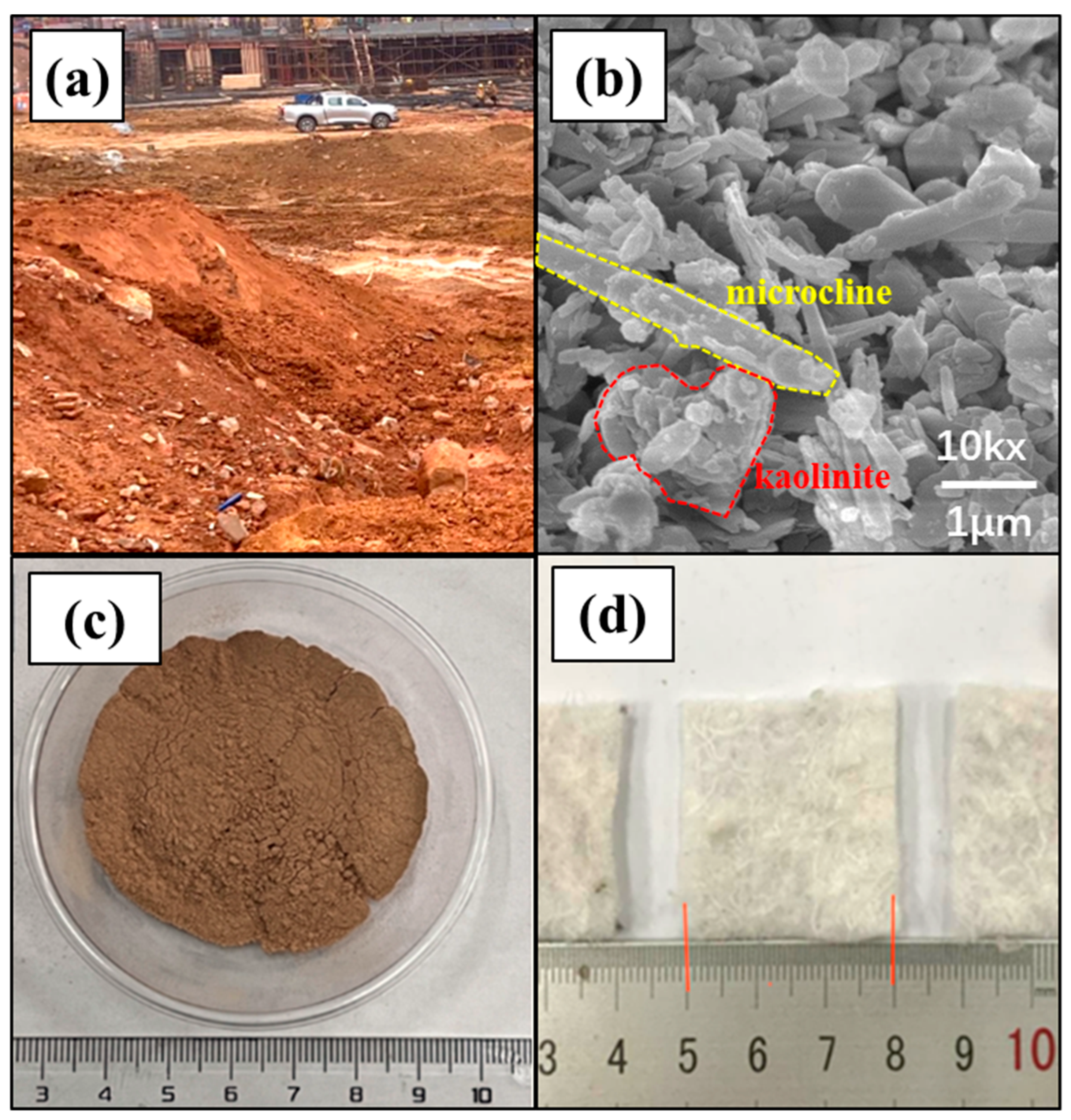
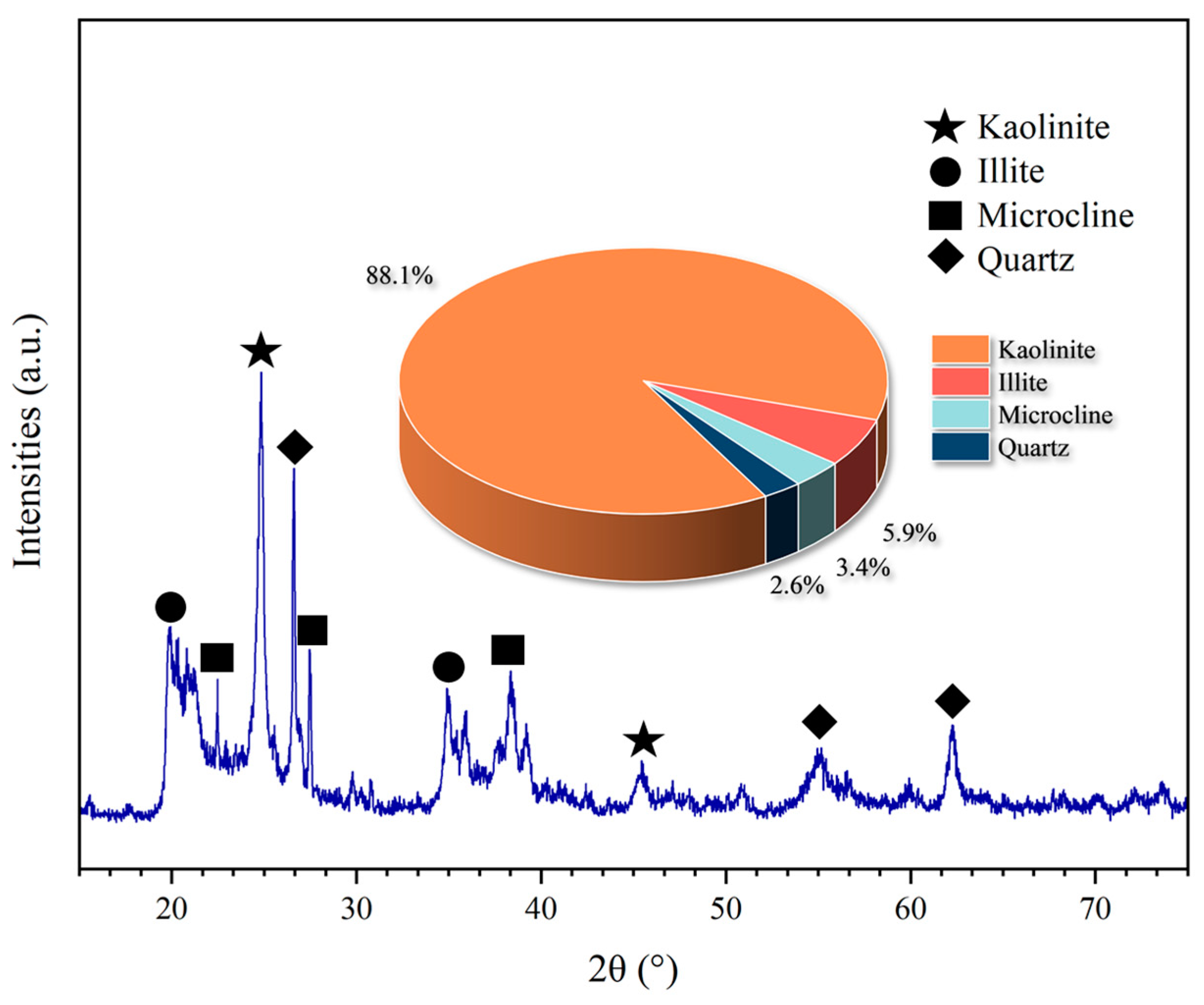



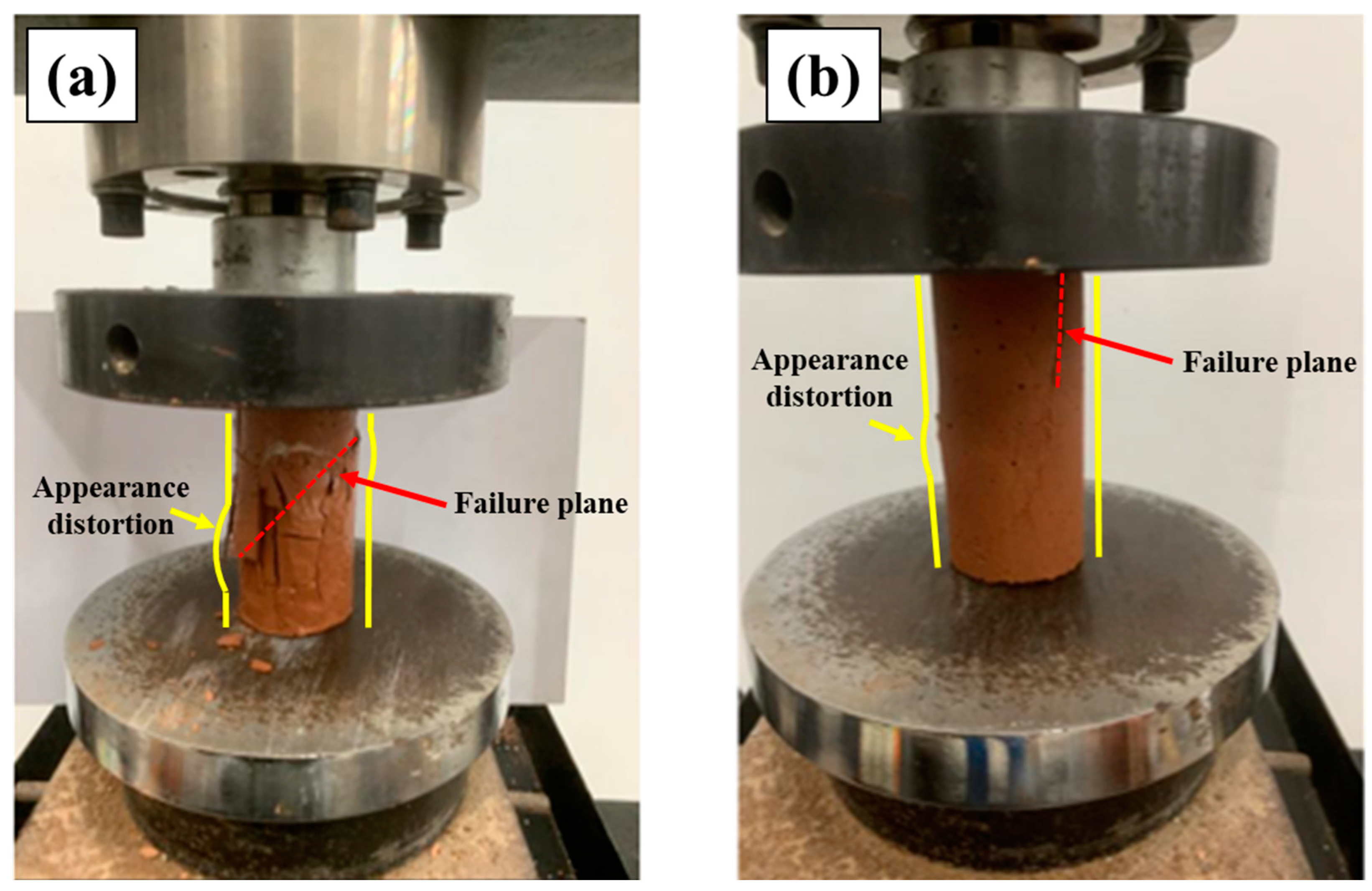


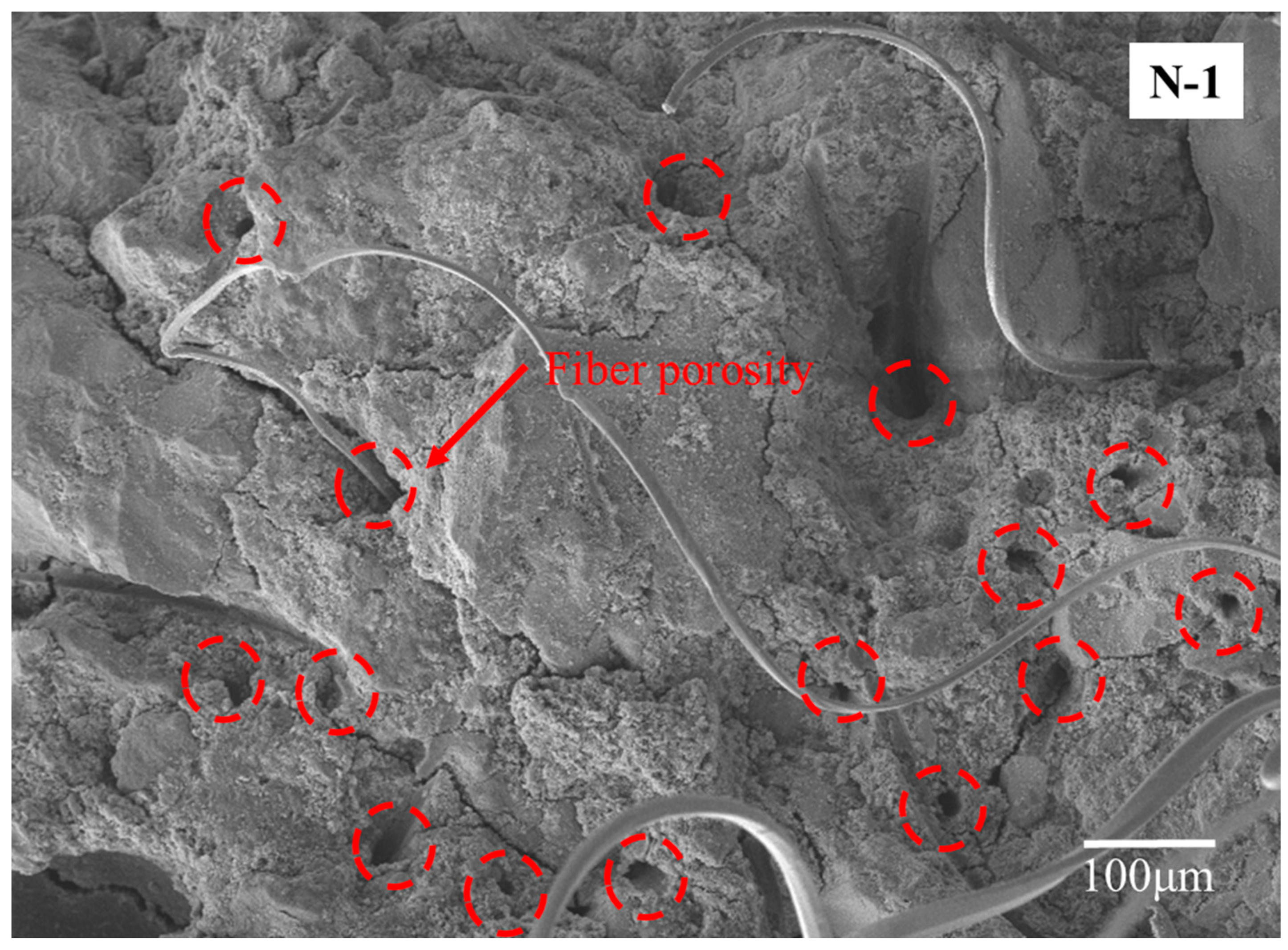
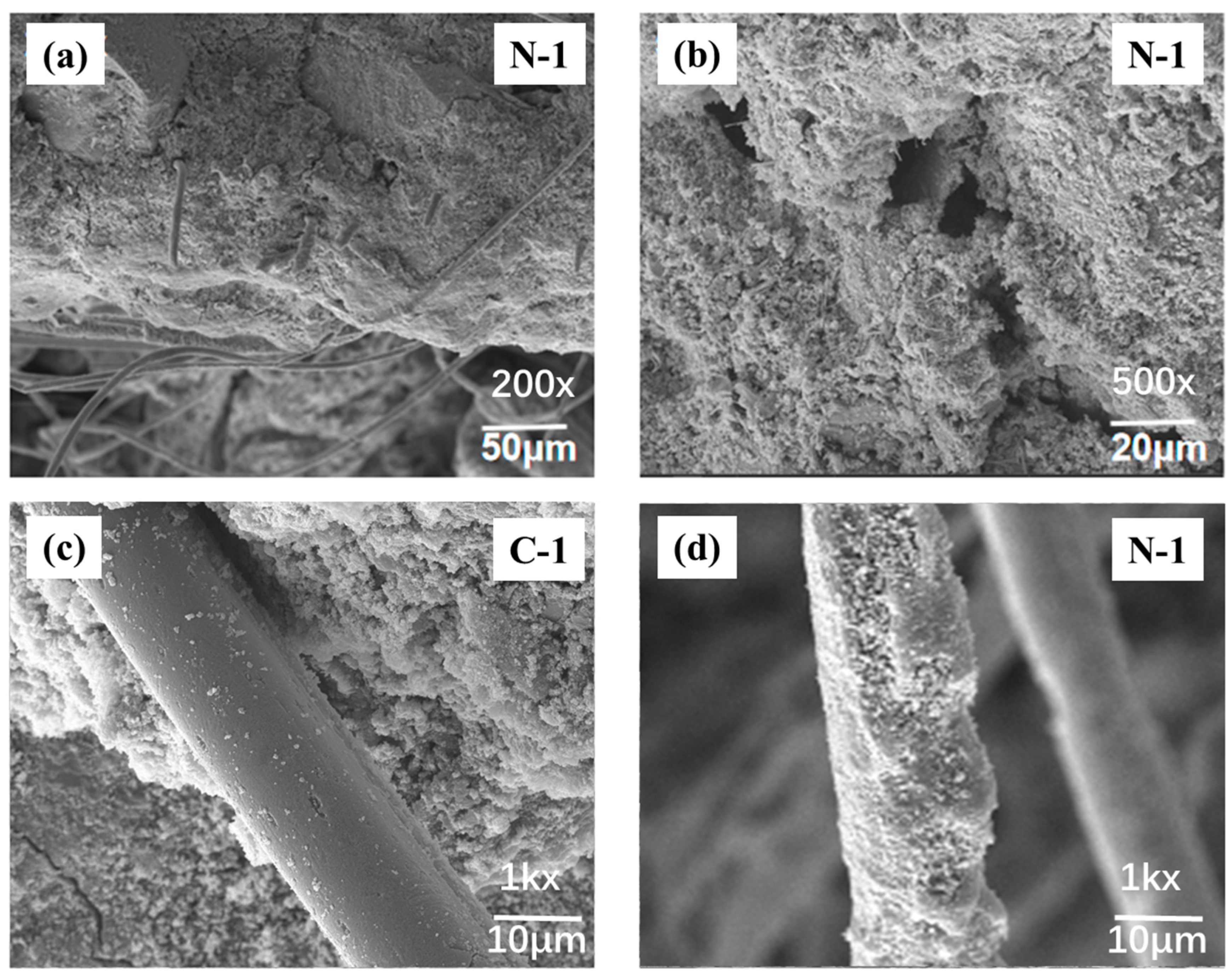
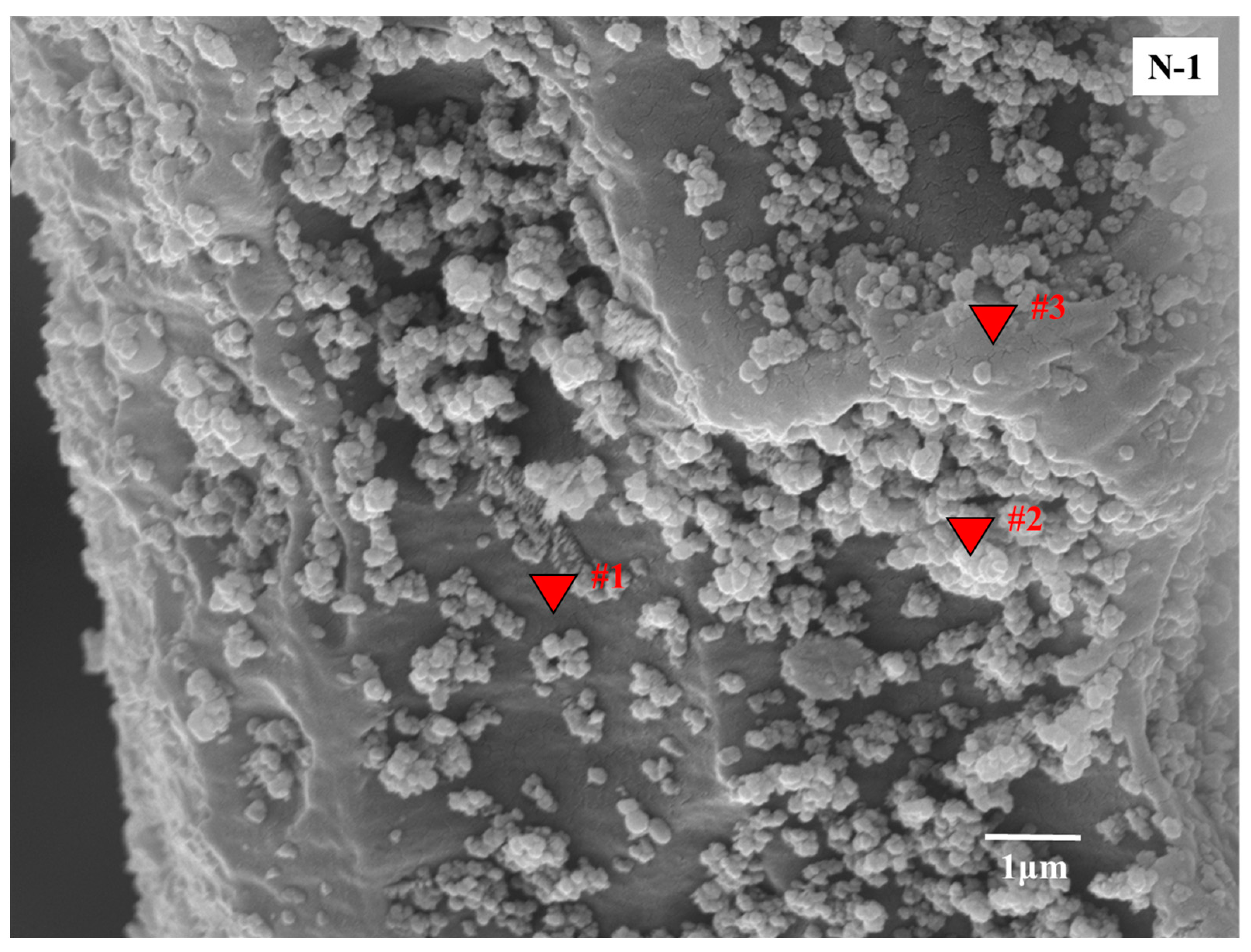


| Properties | Value | Test Method |
|---|---|---|
| Characteristic initial strength (kN/m) | 10 | ISO 10319 [29] |
| Nominal mass (g/m2) | 200 | ISO 9864 [30] |
| Sample | Number of Geotextile Layers | Curing Condition | Experiment Period/d | |
|---|---|---|---|---|
| N-0 | 0 | Natural curing | 7 | 14 |
| N-1 | 1 | |||
| N-2 | 2 | |||
| N-3 | 3 | |||
| S-0 | 0 | Soaking curing | 7 | 14 |
| S-1 | 1 | |||
| S-2 | 2 | |||
| S-3 | 3 | |||
| C-0 | 0 | D-W cycle curing | 7 | 14 |
| C-1 | 1 | |||
| C-2 | 2 | |||
| C-3 | 3 | |||
| #1 | #2 | #3 | |||
|---|---|---|---|---|---|
| Atom | Ratio/% | Atom | Ratio% | Atom | Ratio% |
| C | 76.78 | C | 73.36 | C | 74.39 |
| N | 0.00 | N | 0.00 | N | 0.00 |
| O | 18.11 | O | 19.62 | O | 18.57 |
| Na | 2.05 | Na | 2.57 | Na | 2.57 |
| Al | 1.30 | Al | 1.93 | Al | 1.93 |
| Si | 1.68 | Si | 2.51 | Si | 2.65 |
| K | 0.08 | K | 0.00 | K | 0.05 |
Disclaimer/Publisher’s Note: The statements, opinions and data contained in all publications are solely those of the individual author(s) and contributor(s) and not of MDPI and/or the editor(s). MDPI and/or the editor(s) disclaim responsibility for any injury to people or property resulting from any ideas, methods, instructions or products referred to in the content. |
© 2024 by the authors. Licensee MDPI, Basel, Switzerland. This article is an open access article distributed under the terms and conditions of the Creative Commons Attribution (CC BY) license (https://creativecommons.org/licenses/by/4.0/).
Share and Cite
Zhou, W.; Zhang, X.; Li, H.; Yan, R.; Huang, X.; Gan, J.; Zhang, J.; Cheng, X.; Yuan, J.; Yuan, B. Investigation of the Impact of Geotextile Incorporation on the Mechanical Properties of Geopolymer. Buildings 2024, 14, 2595. https://doi.org/10.3390/buildings14092595
Zhou W, Zhang X, Li H, Yan R, Huang X, Gan J, Zhang J, Cheng X, Yuan J, Yuan B. Investigation of the Impact of Geotextile Incorporation on the Mechanical Properties of Geopolymer. Buildings. 2024; 14(9):2595. https://doi.org/10.3390/buildings14092595
Chicago/Turabian StyleZhou, Wei, Xiujie Zhang, Hongzhong Li, Rongtao Yan, Xianlun Huang, Jianjun Gan, Jinping Zhang, Xiaoyong Cheng, Junhong Yuan, and Bingxiang Yuan. 2024. "Investigation of the Impact of Geotextile Incorporation on the Mechanical Properties of Geopolymer" Buildings 14, no. 9: 2595. https://doi.org/10.3390/buildings14092595





